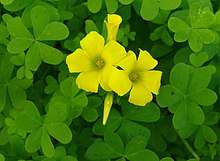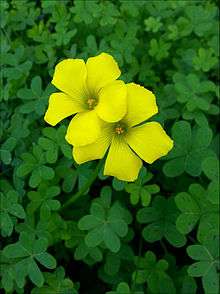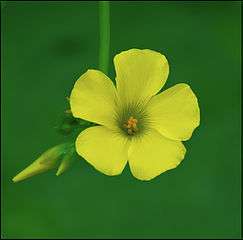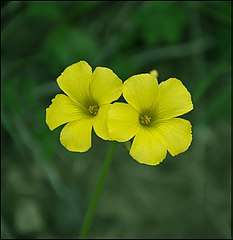Oxalis pes-caprae
Oxalis pes-caprae (Bermuda buttercup, African wood-sorrel, Bermuda sorrel, buttercup oxalis, Cape sorrel, English weed, goat's-foot, sourgrass, soursob and soursop; (Afrikaans: suring) [1]) is a species of tristylous flowering plant in the wood sorrel family Oxalidaceae. Oxalis cernua is a less common synonym for this species.
| Oxalis pes-caprae | |
|---|---|
 | |
| Scientific classification | |
| Kingdom: | Plantae |
| Clade: | Tracheophytes |
| Clade: | Angiosperms |
| Clade: | Eudicots |
| Clade: | Rosids |
| Order: | Oxalidales |
| Family: | Oxalidaceae |
| Genus: | Oxalis |
| Species: | O. pes-caprae |
| Binomial name | |
| Oxalis pes-caprae | |


Description
The Oxalis pes-caprae flower is actinomorphic, with a calyx composed of five free or slightly fused sepals, a sympetalous corolla composed of five fused petals, an apoandrous androecium composed of ten free stamens in two ranks, and a compound pistil. Native populations in South Africa are heterostylous, flowers of long-styled plants have a stigma held above the two ranks of stamens, mid-styled plants have the stigma in between the two ranks of stamens and short-styled plants have a stigma below both ranks of stamen. In the non-native range the plants largely reproduce vegetatively and many populations have only one style length and the plants never produce seed.[2][3] Like most African Oxalis species, it produces adventitious subterranean propagules. These take the form of true bulbs in botanical terms, which is unusual among dicotyledons. In fact, Oxalis pes-caprae produces small bulbs copiously, whereas most other African species produce fewer, larger bulbs. New world Oxalis, such as Oxalis corniculata, apparently do not generally produce bulbs.
Invasive species
Indigenous to South Africa, Oxalis pes-caprae, the "Bermuda buttercup", is an invasive species and noxious weed in many other parts of the world, including the United States (particularly coastal California),[4] Europe, Israel and Australia.[5]
Control
The plant has a reputation for being very difficult to eliminate once it has spread over an area of land.[6] The weed propagates largely through its underground bulbs and this is one reason why it is so difficult to eradicate, as pulling up the stems leaves the bulbs behind. Soil in which the plant has grown is generally contaminated with many small bulbs.
Kluge & Claassens (1990) reported a potential biocontrol agent using Klugeana philoxalis, a larval feeder on shoots of O. pes-caprae.[7][8]
O. pes-caprae is also a host to broomrape, though it is not clear that that is of significance as a control agent.[9]
Uses
Oxalis pes-caprae is often called by the common name sourgrass or soursop due to its pleasant sour flavor. This sourness is caused by the exceptionally high content of oxalic acid.
The plant is palatable and in modest quantities is reasonably harmless to humans and livestock. In South Africa it is a traditional ingredient in dishes such as waterblommetjiebredie (water flower stew).[10]
The plant has been used in various ways as a source of oxalic acid, as food, and in folk medicine. The raw bulbs have been used to deal with tapeworm and possibly other worms. The plant has been used as a diuretic, possibly hazardously, in the light of observations in the following section. The lateral underground runners, which tend to be fleshy, have been eaten raw or boiled and served with milk.[11] The golden petals can be used to produce a yellow dye.[12]
Hazards
Oxalic acid is toxic in large quantities, a concern in regions such as southern Australia where Oxalis pes-caprae grows invasively in enormous quantities and in high densities. Various sources suggest that oxalis ingestion causes calcium oxalate kidney stones, but clinical experience and physiological considerations as described in the Wikipedia article on kidney stone make it unlikely that any realistic intake of Oxalis would affect human liability to kidney stones. Accordingly, some Australian references to the hazards of oxalis to livestock tend to be dismissive of this risk.
However, in spite of its comparatively benign nature, where it has become dominant in pastures, as sometimes happens outside South Africa, Oxalis pes-caprae certainly can cause dramatic stock losses. For example, when hungry stock, such as sheep released just after being shorn, are let out to graze in a lush growth of Oxalis pes-caprae, they may gorge on the plant, with fatal results, as has been found in South Australia at least.[13]
Such stock fatalities patently have little logical connection with the presence or absence of oxalate kidney stones. For one thing, the fatal effects on sheep are far too rapid to result from the growth of bulk kidney stones. The plant has been found to be nutritious, but too acidic to be good fodder, largely being left untouched by grazing stock. When stock do consume large quantities, the effects typically involve death in several weeks with symptoms suggesting chronic oxalate poisoning, including tetany, or sudden death with extensive renal damage.[11] Such damage suggests the twofold effect of calcium immobilisation (the tetany) and the formation of Calcium Oxalate Monohydrate raphides in the kidney tissue.[14] The histotoxic effects of the raphides in kidney have by now been investigated.[15]
Oxalis poisoning of stock is not a serious forage concern in South African pastures, unless exceptionally favoured by overgrazing.
Gallery
 Flowers and leaves
Flowers and leaves Open flower and a bud
Open flower and a bud- Flower detail
- Bulbs and roots
- Entire plant
.jpg)

References
- Bosman, D. B.; Van der Merwe, I. W. & Hiemstra, L. W. (1984). Tweetalige Woordeboek Afrikaans-Engels. Tafelberg-uitgewers. ISBN 0-624-00533-X.
- Rottenberg, Aaron; Parker, John S. (7 May 2004). "Asexual populations of the invasive weed are genetically variable". Proceedings of the Royal Society of London. Series B: Biological Sciences. 271 (suppl_4). doi:10.1098/rsbl.2003.0135. PMC 1810042. PMID 15252985.
- Castro, Sílvia; Ferrero, Victoria; Costa, Joana; Sousa, Ana João; Castro, Mariana; Navarro, Luis; Loureiro, João (2013-08-01). "Reproductive strategy of the invasive Oxalis pes-caprae: distribution patterns of floral morphs, ploidy levels and sexual reproduction". Biological Invasions. 15 (8): 1863–1875. doi:10.1007/s10530-013-0414-2. ISSN 1573-1464.
- Cal-IPC profile
- Department of Primary Industries, Victoria, Australia. "Soursob (Oxalis pes-caprae) (Nox)". Victorian Resources Online. Retrieved 8 June 2017.CS1 maint: multiple names: authors list (link)
- Elmore, C. L. & Cudney, D. W. (January 2002). Ohlendorf, B. (ed.). "Creeping Woodsorrel and Bermuda Buttercup". Pest Notes. Agricultural & Natural Resources, University of California. Publication 7444: 2. Retrieved 25 June 2010.
- Kluge, R. L.; Claassens, M.; "Klugeana philoxalis Geertsema (Noctuidae: Cuculliinae), the first potential biological control agent for the weed Oxalis pes-caprae L."; Journal of the Entomological Society of Southern Africa 1990 Vol. 53 No. 2 pp. 191–198
- "Oxalis pes-caprae". Retrieved 2009-12-22.
- "Oxalis pes-caprae L. (Oxalidaceae); Bermuda Buttercup". Retrieved 2009-12-22.
- S. J. A. de Villiers (2010). Cook and Enjoy. NB Publishers. ISBN 978-0-7981-4919-8.
- Watt, John Mitchell; Breyer-Brandwijk, Maria Gerdina: The Medicinal and Poisonous Plants of Southern and Eastern Africa 2nd ed Pub. E & S Livingstone 1962
- Michael Tortorello (April 5, 2012). "A New Generation Discovers Grow-It-Yourself Dyes". The New York Times.
- Bull, L.; Australian Veterinary Journal, 1929, Vol. 5 p. 60
- McMartin K (November 2009). "Are calcium oxalate crystals involved in the mechanism of acute renal failure in ethylene glycol poisoning?". Clin Toxicol. 47 (9): 859–69. doi:10.3109/15563650903344793. PMID 19852621.
- Wiessner, John H.; Hasegawa, Andrew T.; Hung, Linda Y.; Mandel, Gretchen S.; Mandel, Neil S.; "-- Mechanisms of calcium oxalate crystal attachment to injured renal collecting duct cells"; Kidney International (2001) 59, 637–644; doi:10.1046/j.1523-1755.2001.059002637.x
External links
| Wikimedia Commons has media related to Oxalis pes-caprae. |